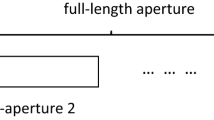Abstract
The beam velocity of geosynchronous synthetic aperture radar (GEO SAR) varies seriously with the orbital position and the scene position, which leads to a significant variation of the scene length and the azimuth resolution in the stripmap (SM) mode. To obtain uniform scene length and azimuth resolution, beam scan modes can be utilized in GEO SAR, such as the sliding spotlight (SLL) mode and the terrain observation by progressive scans (TOPS) mode. However, the conventional design method of the beam scan mode is based on the straight line model (SLM), which does not consider the effects of the curved satellite track and the spherical earth surface. To solve this problem, a curvature circle model (CCM) is proposed considering the actual satellite-earth relationship. By using the CCM, the beam velocity after the beam scan is derived. The scene length and the azimuth resolution are analyzed. The SLL mode and the TOPS mode are recommended for GEO SAR. After that, a design method of the beam scan mode is proposed based on the CMM. The performance of the proposed method is verified by computer simulations.
Similar content being viewed by others
References
Tomiyasu K. Synthetic aperture radar in geosynchronous orbit. In: Proceedings of International IEEE Antennas Propagation Symposium, College Park, 1978. 42–45
Tomiyasu K, Pacelli J I. Synthetic aperture radar imaging from an inclined geosynchronous orbit. IEEE Trans Geosci Remote Sens, 1983, GRS-21: 324–329
Madsen S N, Edelstein W, DiDomenico L D, et al. A geosynchronous synthetic aperture radar: for tectonic mapping, disaster management and measurements of vegetation and soil moisture. In: Proceedings of IEEE International Geoscience and Remote Sensing Symposium, Sydney, 2001. 447–449
Li Y H, Hu C, Dong X C, et al. Impacts of ionospheric scintillation on geosynchronous SAR focusing: preliminary experiments and analysis. Sci China Inf Sci, 2015, 58: 109301
NASA, JPL. Global Earthquake Satellite System: a 20-year plan to enable earthquake prediction. Technology Report JPL 400-1069. 2003
Ding Z G, Shu B Z, Yin W, et al. A modified frequency domain algorithm based on optimal azimuth quadratic factor compensation for geosynchronous SAR imaging. IEEE J Sel Top Appl Earth Observ Remote Sens, 2016, 9: 1119–1131
Wang R, Deng Y K, Loffeld O, et al. Processing the azimuth-variant bistatic SAR data by using monostatic imaging algorithms based on two-dimensional principle of stationary phase. IEEE Trans Geosci Remote Sens, 2011, 49: 3504–3520
Wang R, Deng Y K, Zhang Z M, et al. Double-channel bistatic SAR system with spaceborne illuminator for 2-D and 3-D SAR remote sensing. IEEE Trans Geosci Remote Sens, 2013, 51: 4496–4507
Wang R, Wang W, Shao Y F, et al. First bistatic demonstration of digital beamforming in elevation with TerraSAR-X as an Illuminator. IEEE Trans Geosci Remote Sens, 2016, 54: 842–849
Zeng T, Yin W, Ding Z G, et al. Motion and Doppler characteristics analysis based on circular motion model in geosynchronous SAR. IEEE J Sel Top Appl Earth Observ Remote Sens, 2016, 9: 1132–1142
Zan F D, Guarnieri A M. Terrain observation by progressive scans. IEEE Trans Geosci Remote Sens, 2006, 44: 2352–2360
Meta A, Mittermayer J, Prats P, et al. TOPS imaging with TerraSAR-X: mode design and performance analysis. IEEE Trans Geosci Remote Sens, 2010, 48: 759–769
Yague-Martinez N, Prats-Iraola P, Gonzales F R, et al. Interferometric processing of Sentinel-1 TOPS data. IEEE Trans Geosci Remote Sens, 2016, 54: 2220–2234
Hobbs S, Mitchell C, Forte B, et al. System design for geosynchronous synthetic aperture radar missions. IEEE Trans Geosci Remote Sens, 2014, 52: 7750–7763
Ding Z G, Yin W, Zeng T, et al. Radar parameter design for geosynchronous SAR in squint mode and elliptical orbit. IEEE J Sel Top Appl Earth Observ Remote Sens, 2016, 9: 2720–2732
Ruiz-Rodon J, Broquetas A, Makhoul E, et al. Nearly zero inclination geosynchronous SAR mission analysis with long integration time for earth observation. IEEE Trans Geosci Remote Sens, 2014, 52: 6379–6391
Hu C, Zeng T, Zhu Y, et al. The accurate resolution analysis in Geosynchronous SAR. In: Proceeding of European Conference on Synthetic Aperture Radar, Berlin, 2010. 925–928
Acknowledgments
This work was supported by National Natural Science Foundation of China (Grant Nos. 61370017, 61625103, 61427802 ).
Author information
Authors and Affiliations
Corresponding author
Rights and permissions
About this article
Cite this article
Yin, W., Ding, Z., Lu, X. et al. Beam scan mode analysis and design for geosynchronous SAR. Sci. China Inf. Sci. 60, 060306 (2017). https://doi.org/10.1007/s11432-016-9082-9
Received:
Accepted:
Published:
DOI: https://doi.org/10.1007/s11432-016-9082-9




